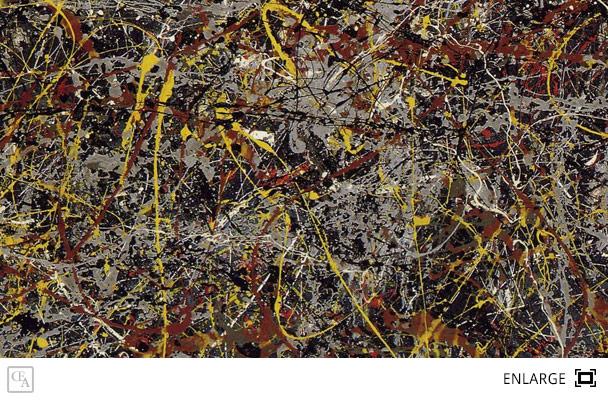
It is 8 feet in height and 4 feet in length, and features a very dense amount of paint that appears disorganized, if still aesthetically-pleasing. The work was painted on fiberboard using liquid paint that was resin-based.
The painting was reportedly sold for 140 million dollars (adjusting for inflation) in 2006, which would make it among the most expensive paintings ever sold, and certainly one of the most expensive of Pollock's works. His paintings are expected to become more expensive as time wears on, since they are rare and very few of his original works still remain in existence. No. 5, however, still survives to this day in a private collection in New York City, though the specific collector is anonymous and unknown to the public. It was initially purchased by Alfonso A. Ossorio during an exhibition in 1949 for 1,500 dollars, who was looking for a paint drip work to add to his collection.
While the painting was being shipped, it was damaged, so Pollock attempted several times to repair the damage by painting over it, but Osorio claimed that he could tell the difference. Pollock instead ended up repainting almost the whole thing, resulting in a different painting from the original, and he reportedly stated that no one would ever be able to tell the difference because no one ever knows how to “look at” his paintings. Ossorio did notice the difference, but he found it to be a positive change, and described the painting as having more depth of character, but still retaining the essence of the original, and even expanding on it. Pleased, he described the work as representing Pollock's “second chance” at producing the same work of art. This flew in the face of more typical art restoration techniques, which seek to make small, slight repairs that won't be noticed by the casual viewer and will result in an exact likeness to the original; instead, Pollock completely reworked his painting, drizzling new lines and embellishments on the older piece underneath.
After Ossorio, the painting moved on through several private hands, from Samuel Irving Newhouse, Jr. to David Geffen, until it was finally sold in 2006 for roughly 140 million dollars to an unknown private collector, possibly to David Martinez, though it is currently unconfirmed. Only one of Pollock's paintings has currently sold for more, Number 17A, which sold for roughly 200 million dollars in 2015 and was sold to Kenneth C. Griffin, a private collector. Similar to No. 5, Number 17A is an abstract paint drip work that incorporates many colors, especially streaks of white in the foreground. It is, however, not as dense and busy as No. 5, likely because it was not painted and repainted several times with several different layers.
 Arts3 Network
Website edition
Arts3 Network
Website edition